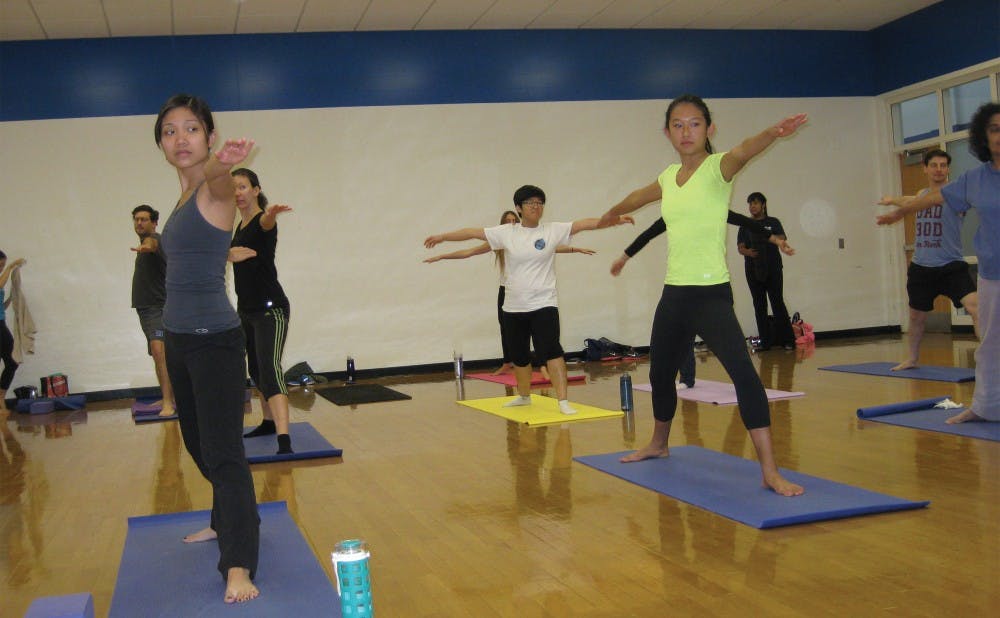Duke students are flocking to take yoga classes—and other students are stepping up to teach them.
Several students teach classes at Wilson and Brodie Recreation Centers as a way to relax, with many also taking advantage of the work-study benefits that can come with such positions. Teaching yoga at Duke requires a number of certifications and a training course, but instructors say that they enjoy sharing their practice with other students on campus.
“Sometimes students lose their balance, fall down and laugh at themselves—and I love that,” said Brittany Zick, Pratt ‘08 and a master’s student in global health, who teaches yoga classes at Wilson. “We have to learn to not take ourselves so seriously and embrace our talents and limitations. That is what yoga is about—understanding your own body and cultivating awareness.”
Yoga offers benefits to both students and teachers in the classes, explained University Group Fitness Coordinator Lisa Jindra, Graduate School ‘10. She said that practicing yoga can improve one’s concentration, balance, flexibility and strength.
“We often say that yoga helps connect the brain, body and breath,” she explained.
Students wanting to become instructors must earn proper credentials before teaching classes at Duke. Jindra noted that each incoming yoga instructor must complete a 200-hour training program, preferably through an accredited Yoga Alliance School, and must also have cardiopulmonary resuscitation, automated external defibrillator and first-aid certifications.
Junior Kathryn Loftus, who regularly conducts her own yoga classes, explained that she completed her 200-hour certification in six weeks full of lectures, poses, reading and homework.
“It became my life for the six weeks I was in training,” she said.
Loftus did not practice yoga often in high school, but said she got more involved during her freshman year at Duke before training to become a yoga instructor as a sophomore. Like Zick, she explained that she enjoys helping students de-stress amid their packed day-to-day schedules.
“The most rewarding part of the job is having people come up to me after class and say that my class was a great way to end their day, or that they have been feeling stressed and yoga helped them,” she said.
Students in the classes also appreciate the opportunity to take their mind off of work and other worries of Duke life.
“Yoga allows me to unwind from a long day and temporarily escape from an abundance of homework and continuous hours of studying,” freshman Iris Yang said.
Practicing and teaching yoga is enjoyable for many on campus, but it can also become an integral part of students’ lives. After being diagnosed with prematurely aggravated genetic arthritis in her third and fourth lumbar vertebrae when she was 12, senior Allison Draper’s physical therapist recommended that she try yoga—a recommendation that has paid off.
“Yoga allowed me to be able to manage my pain on my own, with my own body,” Draper said. “It was empowering, and I was hooked.”
Draper teaches four different yoga classes—Power Yoga, Happy Hour Yoga, Yoga Sculpt and Yin Yoga. Even though the first three classes center on vinyasa flow—a style of yoga in which movements are synchronized with one’s breathing—Draper manages to teach a variety of classes, including some that involve free weight exercises and core workouts.
For example, Yin Yoga is a slow meditative class in which students repeat 10 to 12 poses that are held for three to eight minutes each, while Happy Hour Yoga is an upbeat class set to music.
There are definitely yoga novices at Duke, but Draper noted that most of the students who attend her classes are typically either well-versed in yoga or have prior experience.
“Yoga definitely has a following, so people who are into yoga seek classes out on their own,” she said. “People often get started with the hopes of becoming more flexible, but stick around for everything else that yoga has to offer.”
Zick, who teaches vinyasa flow and hatha yoga—a style that often involves slow-paced classes with more stretching—noted that she became interested in teaching yoga after practicing for 12 years, but wanted more balance and personal interaction when working as a software engineer.
“I like to make sure that everyone breaks a sweat in my class, but I also want to slip in some meditation and relaxation to the class so they truly get the benefits of the yoga practice for the mind as well,” she said.
Get The Chronicle straight to your inbox
Signup for our weekly newsletter. Cancel at any time.

